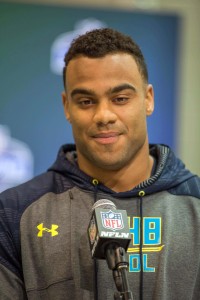As we covered in our contract bonuses entry in the Pro Football Rumors glossary, including bonuses in NFL contracts is a good way to spread out a cap hit that might otherwise be exorbitant. For instance, if a player’s five-year deal includes a $10MM signing bonus, that money can be paid immediately but spread out over five years for cap purposes. So the cap charge for the bonus would be $2MM per year, rather than $10MM in year one.
This practice can come back to haunt teams if they want to get out of a contract early, however. Suppose the team in the above scenario wanted to release the player in the third year of his contract. Even if none of the player’s base salary is guaranteed at that point, the team will still have to account for that remaining prorated bonus money. Rather than counting on the cap as $2MM per year for three seasons, that dead money “accelerates,” and applies to the cap for the league year in which the player is released. In other words, the remaining $6MM in prorated bonus money immediately counts against the club’s cap.
Although these rules apply to many cuts, a different set of rules is in place for players released after June 1. In that case, a team can spread the cap hit across two seasons rather than one — for the current season, the prorated bonus figure stays at its original amount, with the remaining bonus balance accelerating onto the following season. Referring again to the above scenario, that means the player would count against the cap for $2MM in the league year in which he was cut, with the remaining $4MM applying to the following league year.
The guidelines for pre-June 1 and post-June 1 cuts are fairly straightforward, but things become a little more complicated when we take into account that teams are allowed to designate up to two players as post-June 1 cuts even if those players are released before June. This offseason, only two players were designated as post-June 1 cuts — Philip Wheeler, by the Dolphins, and DeAngelo Williams, by the Panthers.
So how exactly does this scenario work? Let’s look at Wheeler’s contract for an example. Before he was cut, the remaining years on the linebacker’s contract looked like this:

Typically, releasing Wheeler prior to June 1 would accelerate all that prorated bonus money to the 2015 cap. His base salaries and workout bonuses don’t feature any guarantees, so that would’ve looked like this:

That approach would’ve ensured that Wheeler’s contract came off the Dolphins’ books faster, but it would’ve barely created any cap space — the linebacker’s cap hit for 2015 would’ve only dipped by $200K, from $4.4MM to $4.2MM. By designating him as a post-June 1 cut, the Dolphins ensured that they’d create more cap space for 2015 by moving some of the dead money to 2016.
Of course, Miami didn’t actually get that cap space until this week, since designating a player as a post-June 1 cut means he’ll come off the books after June 1, rather than immediately. Here’s what Wheeler’s contract looks like now on the Dolphins’ books:

Because the cap charge for the current league year isn’t reduced until June, designating a player as a post-June 1 cut isn’t hugely advantageous for teams. By June, just about every notable free agent is off the board, so the new savings likely won’t be put toward a major move.
Still, releasing a player in March and designating him a post-June 1 cut can be mutually beneficial for a player and his team. It allows the player to hit the market when potential suitors still have cap room and are still looking to add free agents, and it allows the club to spread out the player’s cap charge without having to actually wait until June 1 to release him — waiting until that point could mean paying roster or workout bonuses in the interim. Additionally, even if the team doesn’t need that June cap space for free agency, it can come in handy for signing draft picks.
The 2015 period for designating a player as a post-June 1 cut has ended — every player released now will be, by definition, a post-June 1 cut, meaning any dead money will be spread across the 2015 and 2016 league years. As Jason Fitzgerald of Over The Cap notes in his piece on the subject, this was a bigger deal in past seasons, when teams were right up against the cap and badly needed to create space. These days, clubs are doing a much better job of managing their respective caps, and no teams are in bad enough shape that they were counting down the days on their calendars until June 1.
A couple loose ends related to post-June 1 cuts:
- The same rules applying to players who are released apply to players who are traded — if a team trades a player after June 1, his remaining bonus money can be spread out over two seasons. However, a club can’t designate anyone traded prior to June as a post-June 1 player.
- Teams cannot designate post-June 1 cuts during the final league year of the Collective Bargaining Agreement.
Note: This is a PFR Glossary entry. Our glossary posts will explain specific rules relating to free agency, trades, or other aspects of the NFL’s Collective Bargaining Agreement. Information from Over the Cap was used in the creation of this post. The original version of this post was published on April 2, 2014.






